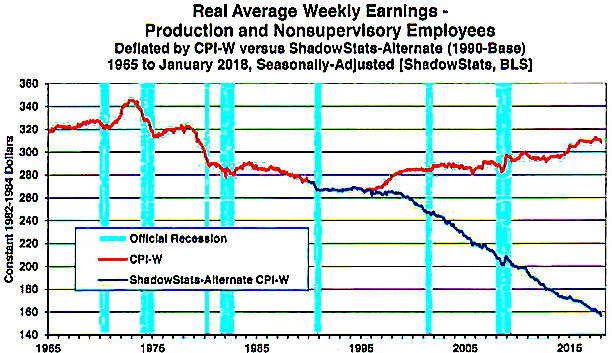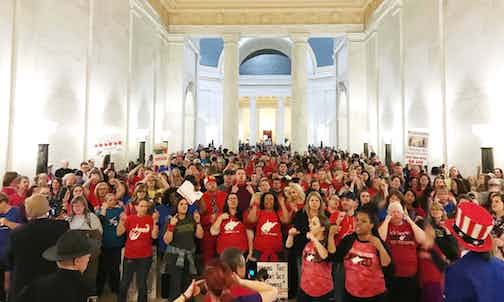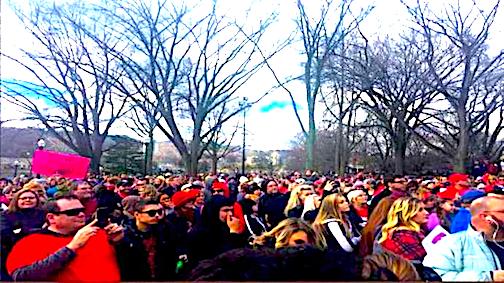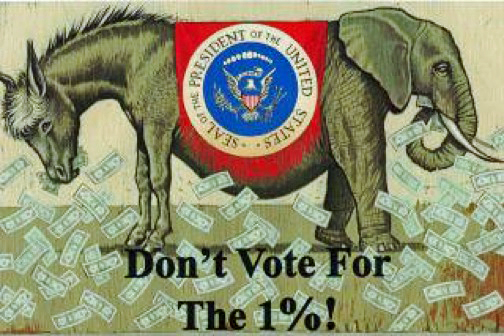Skip to content
I agree most of Bruce Dixon’s article below.(Lessons, Successes, Failures of the West Virginia Teachers Strike) However, I disagree with Bruce’s overall assessment of the trade union bureaucracy. After the defeat of the PATCO Strike, the trade union bureaucracy was scared that they would lose their dues base. They developed, as their strategy to keep the dues check-off flowing to form a partnership with the boss. Whereby, the employers would continue to deduct union dues, in exchange, the labor bureaucracy would subordinate the standard of living of the workers, they represent, to the benefit of their employers.
The result of this partnership with the boss led to the creation by the trade union bureaucrats to set up two and many tier wage schemes to cut the wages for future workers. The results of this policy has been a continual wage cut in real wages and conditions that accelerated since the two tier system was set up in the 1980s. When I was in union office, in the 1990s, we use to characterize this policy as the ‘race to the bottom’. See the graph below:
Shadow Government Statistics Real Average Weekly Earnings, Production and Nonsupervisory Employees, 1965-to-Date The 5% wages that the teachers won, is better than that which the teachers unions initially settled for and urged the teachers to go back to work. The teachers ignored the union ‘leaders’ and stayed out of work for a few more days. The 5% settlement with the goverentment does not represent the increase of living. According to Shadow Government Statistics real inflation is 10%. And the labor bureaucracy got a guarantee that the state will deduct union dues from paychecks, for opposing the strike.
The 5% wages that the teachers won, is better than that which the teachers unions initially settled for and urged the teachers to go back to work. The teachers ignored the union ‘leaders’ and stayed out of work for a few more days. The 5% settlement with the goverentment does not represent the increase of living. According to Shadow Government Statistics real inflation is 10%. And the labor bureaucracy got a guarantee that the state will deduct union dues from paychecks, for opposing the strike.
Unfortunately, there is no mention of healthcare in the settlement. “A wildcat teachers’ strike that roiled West Virginia for nine long days ended on Tuesday, after the state government passed a 5% pay hike. For a state that doesn’t even allow state employees to engage in collective bargaining, this amounts to a historic victory. Yet much remains undone. The strike was largely about healthcare benefits, which the deal mostly skirted. Even worse, the educators’ hard-won raise could come at the expense of other important state programs – potentially Medicaid, although this remains uncertain. Such an outcome only reaffirms a lesson made explicit throughout labor history: universal healthcare programs, rather than private benefits won through collective bargaining, must be a priority for organized labor.”(The West Virginia teachers’ strike is over. But the fight for healthcare isn’t)
And all this is under that back drop that the Supreme Court Will Hear Case on Mandatory Fees to Unions. In the labor case, the court will consider whether public-sector unions may require workers who are not members to help pay for collective bargaining. If the court’s answer is no, unions would probably lose a substantial source of revenue. That would break initially break the basis for the labor management partnership. This why the local and international teacher unions did backflips to say, along with the government, that it was a wildcat strike and that they had nothing to do with the strike.
Where’s Our Party?
When a union is in at struggle with the government, it immediately becomes a politic fight and the workers have no political organization that represents them and is of them,
The teachers potentially have huge political power, for teachers are in contact with the entires working class, through teacher and parent organizations. The key for the fight to go forward is for the West Virginia Teachers to go forward is to maintain their strike organizations and have weekly meetings in the towns where they were organized for the strike. They were able to get the support of the working class. (When they made healthcare as part of their demands the teachers strike gained the support of the whole working class. These committees could fight for health care and against austerity. And in this process, build the political power — a workers political Party.) — to oppose the republicrat government and austerity!
The first not at all new lesson is that successful strikes are possible wherever an overwhelming majority of the workforce is committed to it, whether or not those worker are in a “right to work ” state, and whether or not the strike is endorsed by their union if they have a union at all. Neither of West Virginia’s two teachers unions endorsed the strike, and the leaders of both unions initially and repeatedly attempted to “settle” it for far less than the striking workers demanded.
A second lesson was that illegal strikes can succeed. Although a teacher walkout was explicitly prohibited by state law Governor Jim Justice dared not seek an injunction ordering teachers and others back to work because they enjoyed far too much public support. The largely successful New York City transit worker strike of December 2005 was illegal too, but workers achieved most of their objectives, despite the fact that the union leadership was forced by the authorities to resign and spend a few days in jail.
A third not at all new lesson was that all for one and one for all solidarity is key to successful strikes. Back in 1990 when teachers struck, school bus drivers were taking children right through their picket lines into the schools. This time the teachers went out along with the janitors, the bus drivers, the food service workers all demanding a 5% across the board pay increase, not just for school employees but for all state workers, along with a fix on ballooning health care premiums, out of pocket costs and an end to invasive and humiliating requirements for continued health insurance. When state legislators offered raises to the teachers alone they were emphatically hooted down.
A fourth lesson is that what happens in a workplace isn’t confined to that workplace. A worker is a whole person, a renter or mortgage debtor, a student loan debtor, a member of this or that church or other formation. People carry their home concerns into the workplace, and their workplace concerns home. They don’t stop being parents or residents of communities poisoned and pillaged by greedy extractive industries when they go to work. Part of the popularity of the teachers’ cause was their demand that the urgently needed health insurance fix come from a tax on the energy companies which have ravaged the state’s land and people the last dozen decades.
A fifth lesson, again not a new one at all is that in a wildcat strike the union officials may want to prematurely settle. The West Virginia strike was organized from the bottom up, not by union leaders. Beginning the second day of the strike union leaders and the governor’s office were already announcing its conclusion, the first time based upon a mere handshake with the governor. Teachers at the state capital and impromtu meetings in malls and other locations around the state rejected these premature deals. The final back-to-work agreement was distributed to workers, according to the World Socialist Website via robocall before the governor had signed any legislation.
What the teachers got, what they didn’t get.
What the teachers got was a 5% pay increase for all state workers, from cops to secretaries to janitors, assuming these are not outsourced as they are in most places nowadays, and a guarantee that the state will deduct union dues from paychecks, along with the understanding that unions are free to use these funds for political purposes.
They didn’t come close to achieving a tax on energy companies to fix the health insurance mess. They settled for representation on a so-called “task force” which is supposed to look into fixes for the state’s public employee health plan, and report back in October, theoretically in time for teachers and their allies to punish uncooperative parties at the polls. Some teachers called it a sellout.
But with two nearly interchangeable parties of capital in power, the outlook is far from rosy. Both houses of West Virginia’s legislature are dominated by Republicans, and most politicians of both parties are deep in the pockets of global corporations that shear off, grind up and sift entire mountain tops for the remaining coal, that poison the state’s water extracting shale and natural gas and which dump their toxic leavings pretty much wherever they please.
Governor Jim Justice is a billionaire scofflaw, the richest man in the state with holdings in resorts, energy companies and more who switched to the Democratic party to win the governorship in 2015, and rejoined the Republican party in 2017 to get on the Donald Trump train. Both West Virginia teachers unions endorsed Justice in his run for governor. A 2016 NPR investigation identified $15 million in delinquent taxes and fines owed by the governor’s mining companies in six states including $6.8 million in Kentucky and $4.7 million in West Virginia. By contrast, in many states (including Virginia but not West Virginia) nonpayment of state taxes or delinquent student loans will get your drivers license and/or professional license suspended.
The governor says the first year’s pay increase can be paid for with money the state already has, though it may be “prudent” to cut Medicaid. Republican legislative leaders however, declare that any pay increase must come from cutting money the state provides to local governments and Medicaid, which pays for the medical care of many poor children in West Virginia schools. Sick children, the poor and disabled do not possess the weapon of the strike. So there’s that. If some teachers feel both victorious and a bit sold out at the same time it’s easy to understand.
Anecdotal evidence indicates that union membership may be rising in West Virginia, as many who did not see the need for a union before this, or those who imagined they couldn’t afford to pay union dues are reconsidering. Though union leadership seemed more intent on ending the strike quickly than achieving its goals, union members in local schools figured prominently in the strike and the efforts leading up to it.
Last month, during oral arguments of the Janus case before the Supreme Court, labor lawyers declared that union recognition in a way, is the price for labor peace. When employers declare war upon organized workers, they should not be surprised when workers do the same to them, with or without the sanction of their unions. The fight is far from over in West Virginia, and teachers in Kentucky, Ohio and Oklahoma are considering the possibility of statewide job actions. In Oklahoma City the school board and superintendent are on record backing teachers if they decide to strike for more pay and better funding for schools there.
2018 is an election year, and there is little doubt that Democrats will attempt to harness and divert as much of this energy into the safe channels of their billionaire funded party, as they did in Wisconsin back in 2011. Starving and de-funding public education and breaking teacher unions have been the bipartisan project of both parties for a long time now. There are sharp struggles ahead.
The West Virginia teachers’ strike is over. But the fight for healthcare isn’t The strike was largely about healthcare benefits, which the deal for the most part skirted A wildcat teachers’ strike that roiled West Virginia for nine long days ended on Tuesday, after the state government passed a 5% pay hike.
For a state that doesn’t even allow state employees to engage in collective bargaining, this amounts to a historic victory. Yet much remains undone. The strike was largely about healthcare benefits, which the deal mostly skirted. Even worse, the educators’ hard-won raise could come at the expense of other important state programs – potentially Medicaid, although this remains uncertain. Such an outcome only reaffirms a lesson made explicit throughout labor history: universal healthcare programs, rather than private benefits won through collective bargaining, must be a priority for organized labor. Between rising healthcare costs on one hand and public austerity on the other, West Virginia’s teachers’ health insurance plans had grown gradually worse in recent years, reflecting the situation throughout much of the country. As one teacher told the Los Angeles Times, pay was “not what kept us out. It’s the insurance. That’s the big deal.” By Adam Gaffney

 The 5% wages that the teachers won, is better than that which the teachers unions initially settled for and urged the teachers to go back to work. The teachers ignored the union ‘leaders’ and stayed out of work for a few more days. The 5% settlement with the goverentment does not represent the increase of living. According to Shadow Government Statistics real inflation is 10%. And the labor bureaucracy got a guarantee that the state will deduct union dues from paychecks, for opposing the strike.
The 5% wages that the teachers won, is better than that which the teachers unions initially settled for and urged the teachers to go back to work. The teachers ignored the union ‘leaders’ and stayed out of work for a few more days. The 5% settlement with the goverentment does not represent the increase of living. According to Shadow Government Statistics real inflation is 10%. And the labor bureaucracy got a guarantee that the state will deduct union dues from paychecks, for opposing the strike.

